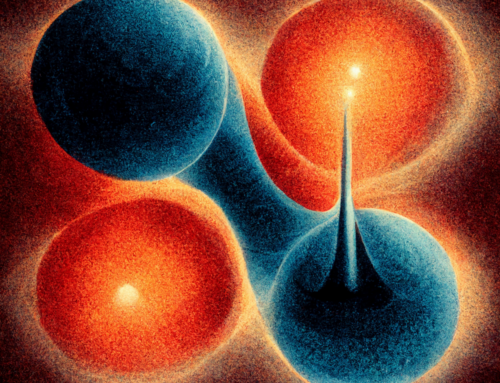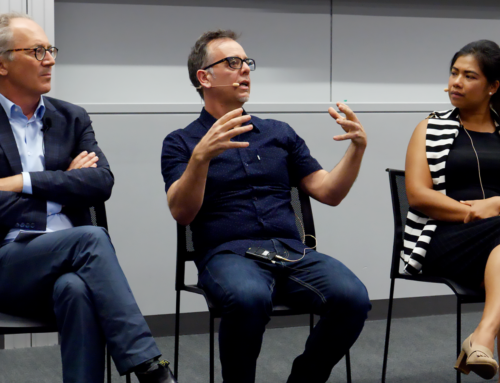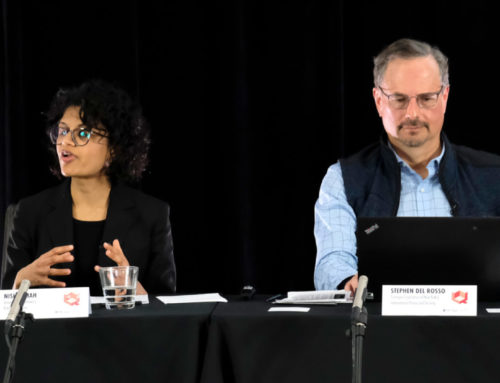As Q2’s attendees assembled to catch a ferry to Q station on Friday morning, traces of McKenzie Wark’s lecture the night before were manifesting in conversations and the space itself. Near the pier sits a plaque commemorating the spot where the 1st Infantry Battalion of the Royal Australian Regiment left to fight in Korea in 1952. This plaque mentions another 1st Battalion, one inaugurated in Sydney on August 17, 1914, that also left from Circular Quay on a tour of duty that would take it to Cairo, Gallipoli, and the Western Front. It later became a garrison reserve unit during the Second World War, and came briefly under the command of Blair Anderson Wark (McKenzie’s great-uncle, introduced in his lecture the night prior) before his untimely death in 1940.

Plaque commemorating Australia’s 1st Battalion in Circular Quay. (Photo: Register of Australian War Memorials)
Like the stone in which the plaque is embedded, the space and time of the First World War remains somewhat of a bedrock for so many aspects of security and geopolitics of today. The war’s impacts persist in time and space through emerging states and nationalisms, the rise of the modern international organizations and endeavors of “collective security”, and physical reminders both intentional and not (the annual “Iron Harvest”, for example, when farmers across Western Europe uncover hundreds of tons of unexploded ordinance in their fields). For a conference interrogating these impacts and parsing their contemporary relevance, Circular Quay was a fitting point of departure.
As the ferry pulled into Q Station’s small wharf after a quick trip across the harbor, a buzzing comes across the sky. A new buzzing began among the participants, realizing their welcome to Q Station by a quadrocopter making passes over the pier. With this bit of drone détournement provoking everything from bemusement to mild dismay among the passengers, the observation apparatus had already begun disturbing the behavior of the system.
After a quick refueling of lunch and coffee, a distinctive smoky smell wafted in from outside. A new buzzing began, much different, lower and punctuated with breathy thumps. Attendees were led outside to two men: one crouched singing over a small fire and the other sitting cross-legged, pumping his breath into a didgeridoo. The singer introduced himself as Matthew Doyle, from the Muruwari Nation, and the other man as Brock Tutt of the Yuin Nation. He then acknowledged the other clans with custodianship of the land around us before welcoming the Symposium to aboriginal lands and explaining that visitors and travellers traditionally sought the welcome of whichever clan was the land’s traditional keepers. The smoke of a smoking ceremony, he explained, both cleanses and protects its participants.

Matthew Doyle explains the significance of the smoke ceremony as Brock Tutt looks on. (Photo: Gilbert Bel-Bachir)
Doyle then spoke a bit on the conference’s theme of commemoration and history. He mentioned his work reviving a song first penned by Bennelong, a member of the Wangal Clan whose house had been right on Circular Quay, not a stone’s throw from the 1st Battalion plaque. Bennelong was the first Australian to visit England, at the behest of early colonialists and composed the song in reference to this journey. Doyle explained the song as one of homesickness, an ode to the affect of changes to one’s space. After he finished singing it, he gestured in the direction of nearby cave paintings, defaced and vandalized. In Doyle’s words, there seemed, a different kind of homesickness, one induced by the drastic changes of time over a single space. Wishing Symposium participants a safe and healthy stay, Doyle and Tutt brought their ceremony to a close.
The proceedings passed to a new master of ceremonies. CISS Director James Der Derian–whose intellectual, grantwriting, documentary, and logistical labors (along with those of his CISS team) brought Q into becoming– aimed his opening remarks at the understandable questions and reservations of attendees.
We were there, he explained, to be quarantined from the every day after taking a “transoceanic leap of faith” to partake in what is becoming an annualized series of collaborative thought experiments. This year’s experiment was to “disturb and de-familiarize” the conventional view of the First World War. And there was, of course, a quantum component. Do the war and the subsequent quantum turn have more than just a chronological correlation? And why did quantum discoveries revolutionize understandings of the physical, but largely stop short of the social?
The conference, he reiterated, was an experiment. As such there needed to be a spirit of risk-taking, an embrace of uncertainty that went beyond just token appropriation of a quantum concept. He wanted participants to feel secure in taking chances, asking questions, and pushing into the unfamiliar. Participants should simply “go for it.” What would emerge over the course of the conference was important, he argued, for reasons of discipline and group research, yes, but all the more so because he felt that the world keeps making the same mistakes in international security. As an event expanding the scales of science and warfare to leave 20 million dead and a political order in disarray, Der Derian described the war as “the calamity that produced the calamities of the 20th century”.
Like any experiments, the conference would be under observation. Der Derian opined that social scientists have an obligation to not only grapple with the implications of their questions but also find a new media fluency to publicize their findings. He re-iterated that the conference was being filmed to produce a documentary to help share the conference’s ideas and debates with a wider audience.
It was then time to introduce the opening panel. “The Space-time of War and Diplomacy,” featuring Chris Fuchs, Arthur I. Miller, Stephen Kern and discussant Glenda Sluga, brought together a pragmatist quantum physicist, a physicist-cum-historian, and two historians to speak to the broadest themes of the conference. Each, Der Derian explained, has produced work that crosses disciplinary boundaries and had written key articles or books that have grappled with the kind of questions Q is dealing with.

Chris Fuchs introduces his presentation on QBism as fellow panelists Glenda Sluga, Stephen Kern, and Arthur Miller (L-R) look on. (Photo: Gilbert Bel-Bachir)
Chris Fuchs (see below for video) went first. His research program of Quantum Bayesianism (or QBism), developed with his colleagues Rüdiger Schack and David Mermin, seeks to resolve long-running controversies over paradoxes that result when one treats quantum states ontically, i.e. as “real things” existing independently of the physicists using them in their calculations. By instead treating quantum states epistemically, QBism subscribes to an interpretation in which quantum states exist only in the mind of the observer.
Responding to Der Derian’s imploration for participants to go for it, Fuchs opened with an anecdote about the American pragmatist philosopher William James. In his recollections of the catastrophic San Francisco earthquake of 1906, James recounted feeling a desire to invite the tremors to “Go it… and go it stronger!” QBism, Fuchs explained, takes the notorious “weirdness” of quantum mechanics and goes it weirder in order to make it stronger. Having elsewhere likened the QBist project to one of vaccinating quantum theory against a catastrophic disease, QBism seeks to rectify quantum’s apparent paradoxes by putting the perceiving subject back in the science.
To demonstrate the implications of such a move, Fuchs introduced the notorious “measurement problem”. Quantum mechanics gives the probability of polarization in a double-slit experiment, but Fuchs felt compelled to ask: “Does measurement reveal a pre-existing, but unknown value? Or does it in some sense go toward creating the very value?” The founders of quantum mechanics largely attempted to settle this question verbally. Schroëdinger developed his notion of quantum “entanglement”, while Einstein, Podolsky, and Rosen’s (EPR) 1935 paper laid out a criterion of reality in which, “If, without in any way disturbing a system, we can predict with certainty (i.e., with probability equal to unity) the value of a physical quantity, then there exists an element of physical reality corresponding to that physical quantity.” But there the problem rested for nearly thirty years before the work of Bell, Kochen, and Specker opened up a new set of mathematical and experimental inquiries that could be made into these fundamental issues.
Experiments since then that have ever more stringently confirmed the validity of quantum mechanics, have at the same time only seemed to deepen the “spookiness” of the theory. By introducing personalist Bayesianism and treating probabilities as subjective information open to revision (or updating) with new information, QBism doesn’t so much solve the “measurement problem” as dismiss it. In QBism, wave-function collapse occurs not in a physical reality but in the mind of an observer who updates their information after measurement.
This is because measurement requires an action on the universe, catalyzing the experience of the observer as acting in the world. We are, Fuchs suggested, often misled by the metaphorically identifying observation with the sense of vision, or the ability to watch or witness without disruption or implication. Fuchs instead suggested that we should connect observation with the sense of touch: that quantum measurement apparatuses should be thought of as extensions of the experimentalist themselves. In this way, each quantum experiment acts in some small way to change or create parts of the universe.
The QBist interpretation encounters resistance from a field reluctant to abandon its belief in an ‘objective’ universe in which quantum states exist as observer-independent things. We– as subjects, agents, scientists– change and make history, our efforts at knowledge effect and influence a universe of change and emergence. Fuchs closed his presentation with more from the proto-QBist William James. Describing a pragmatist/QBist universe versus a rationalist one, James had written: “On the one side, the universe is absolutely secure, and on the other it is still pursuing its adventures.” If the universe is a QBist one, it is a universe that is always in the process of creation.
The adventure of creativity is an area of specialization for the panel’s next presenter, Arthur I. Miller (click for video). Miller, an Emeritus Professor of History and Philosophy of Science at University College London, writes extensively on the similarities in creative thinking between the arts and sciences and the influence of the two fields on one another.
His presentation, titled “How the Avant-Garde of the early 20th Century Affects International Security of the 21st”, looked at innovations in both the arts and sciences that challenged what he called “traditional knowledge” in all fields. In the avant-garde of the early 20th century, the principal problem was to redefine classical intuitive ways of understanding space and time. Highly creative artists responded, Einstein and Picasso chief among them. They saw their breakthrough works – Einstein’s 1905 relativity theory and Picasso’s 1907 Les Demoiselles d’Avignon which contained the seeds of Cubism – to be extending the achievements of their predecessors, especially Newton and Cézanne. But what actually occurred was something quite different.
In parallel Einstein pursued research that would eventually undermine classical physics – the light quantum which violated the venerable laws of electromagnetic theory according to which light was a wave and not a particle and would eventually be a corner stone of quantum physics. While extending previous art styles, Picasso inspired a totally abstract art that would shatter them.
These innovations weren’t limited to physics and painting. Miller talked of Debussy and Satie breaking with classical music. Satie, in particular, sometimes used no bars, ran harmony against dissonance and composed with a minimalism often exhibiting extreme repetition. In literature, Proust’s In Search of Lost Time and later James Joyce’s Portrait of the Artist as a Young Man and Ulysses continued to break with the classical forms of the 19th century.
According to Newton’s science – the Newtonian Clockwork Universe – systems unfold continuously from in-principle precisely determined initial conditions in a predictable or causal manner. It mirrored phenomena as they occurred in our daily world and had an impressive track record. The military thought so too and, in the 1870s, responded with a military science styled on it.
By Miller’s estimation the military would have nothing to do with the subversive undercurrents in the avant-garde, despite warnings in the 1870’s by the Chief of the Prussian General Staff von Moltke that as soon as battle commences all plans go out the window. Forget the Newtonian Clockwork Universe.
But the successes of the Newtonian Clockwork Universe, in addition to the fact that there were no major conflicts between 1870 and 1914, lulled war planners into a lethargy in which they were convinced that it held also for military planning.
Miller described “a timetable war” evolved from initial conditions with the assumed predictability of the Newtonian Clockwork Universe: a scheduled artillery barrage before men went “over the top” to march across no-man’s land at a pre-planned pace behind a moving curtain of fire in order to capture a particular objective at a certain time at which point officers stopped to regroup. Taking individual initiative to exploit a potential breakthrough was not permitted. Such a move had to be cleared with supreme command located far beyond the lines and difficult to communicate with.
Miller suggested a pattern of “symmetry/asymmetry/symmetry” in which stagnation would be punctuated with a breakthrough- technological, strategic, or logistical- only for balance to be restored by a counter development.
The German offensive of 1918 was driven by the innovative use of storm trooper tactics. But the commander-in-chief, Ludendorff, was indecisive and uncomfortable with this fluid situation and did not exploit potential breakthroughs, in the end insisting on maintaining the original plan.
German assault troops spent themselves and symmetry was restored to be broken with the arrival of American troops on the front line. Miller, pointing out the possibility, among others, briefly illuminated by the German offensive in 1918, wondered aloud, “What if the military had been more aware of the kind of avant-garde developments that had both extended and subverted the classically intuitive ways of understanding space and time? Might they have been more flexible?”
How did militaries and chancellories grapple with changing perceptions of space and time? The panel’s last presentation, by Stephen Kern (click for video), looked to explore this question through posing a few questions of his own. Kern, a Humanities Distinguished Professor at Ohio State, drew largely from ideas that he first began exploring in The Culture of Time and Space: 1880-1918 to ask how the cultural and technological changes in the lived experiencing of time and space affected the outbreak and execution of the war itself.
For the first of four questions that would provide the foundation of his talk, Kern asked, “Does technology drive history?” Kern responded that the technologically-driven war was an interruption of intense creative development. Kern also considered the role that technology played in the dramatic diplomacy of the July crisis, a crisis exacerbated by the entanglement of technology and accelerationism into a cultural practice of diplomacy that had been, in Kern’s words, “an art of timing and delay.”

Stephen Kern talks about the culture of space and time in the early 20th century. (Photo: Gilbert Bel-Bachir)
European diplomats in the July crisis were put under considerable pressure by the specificity of their railway-dependent mobilization plans, further shrinking the size of any windows of opportunity for diplomatic solutions. Kern pointed to a diplomacy of accelerating ultimatums, as Austria-Hungary’s ultimatum to Serbia with a 48-hour time limit would shrink to a mere five hours given by the English for Germans to leave Belgium. These ultimatums were made necessary by military planning that depended on immense mobilizations, but made possible by the adoption of wireless and telephone communications.
Kern explained that throughout the 19th century, diplomatic corps of traditional aristocrats versed in protocol and performance were ill-equipped to have their reasoned and personalist practices upended by the new technologies of war and diplomacy. He noted in the diplomacy of the era a sense of chronological discombobulation, best embodied by a passage he quoted from Sir Ernest Satow’s A Guide to Diplomatic Practice (1917):
“The moral qualities of—prudence, foresight, intelligence, penetration, wisdom—of statesmen and nations have not kept pace with the development of the means of action at their disposal: armies, ships, guns, explosives, land transport, but, more than all that, of rapidity of communication by telegraph and telephone. These latter leave no time for reflection or consultation, and demand an immediate and often a hasty decision on matters of vital importance.” (as quoted in Culture of Time and Space, 275)
Kurt Rietzler, an advisor in the German chancellery, captures in his diary this palpable anxiety on the eve of the war:
“The last days the Chancellor almost constantly on the telephone… The first telegrams about the reaction of the great powers to the Austrian ultimatum arrived, in an hour they go to Berlin. What will our destiny be? But destiny is for the most part completely stupid and uncertain and all entangled in pure chance. Whoever grabs it, gets it. This damn crazy world has gotten too confused to comprehend or predict. Too many factors all at once.” (as quoted in Culture of Time and Space, 276-277)
Kern’s second question extended the phenomenology of time and space to the collective identities of the state: “Did the different ways that different nations experience time and space play a role in the war?”
By Kern’s estimation, there was a phenomenological divide in the experience of space and time between the Triple Entente and the Triple Alliance. The leaders and population of Britain, France, and Russia all had long identifications with their territorial and political unity. On the other hand, Germany, Italy, and Austria-Hungary had only a few decades of existing in the forms they then did. They further had no reason to take their futures for granted. Austria-Hungary had already considered itself to be on the verge of decrepitude and internal fragmentation along ethnic lines, an apocalyptic sense only further heightened by the assassination of Archduke Franz Ferdinand by Serb nationalists. A fear of territorial einkreisung (encirclement) and the prospect of a two-front war Russia and France with a British naval blockade haunted Germany’s leaders, who felt a pressing need for decisive and pre-emptive action.
A third question: “Do big events need big causes?” Kern felt not. He mentioned that Serbia actually agreed to nine of Austria-Hungary’s original ten demands and that the one disagreement arose from a misunderstanding of an Austrian desire to participate in the investigation– but not the trial– of Archduke Ferdinand’s assassins. Had Gavrillo Princep missed, or Ferdinand’s driver not taken a wrong turn, there might have not been war.
To conclude, Kern wondered what lessons the First World War could hold for contemporary security. He broke his answer into component parts that touched on nationalism, imperialism, alliances, domestic politics, and diplomacy.
For nationalism, tensions around Alsace-Lorraine and the subject nationalism included in the 1867 compromise that created the dual monarchy of the Austro-Hungarian empire increased enmity between the war’s combatants and tensions within them. Kern looked to the war’s legacy of nationhood in the Middle East to show the continuing relevance of these tensions in multi-national states and the contemporary resurgence of revanchist revisionism.

Alfred Bettanier’s “The Dark Stain” (1887) depicts French schoolchildren being taught of France’s “lost provinces” of Alsace and Lorraine, colored black on the map. (Photo: Wikimedia Commons)
On a similar note, imperialist rivalry helped to bring war to Europe. Do imperialism’s contemporary analogues, whether wars on terror or globalization, have a similar effect? Treaty obligations have also continued to play a significant role in global security; it would be a mistake to consider Russia’s recent policies in Georgia and Ukraine without taking into account earlier attempts to integrate these countries into NATO expansion plans.
For domestic politics, spending on developing and procuring arms continues to be a vital state effort with significant domestic effects. Meanwhile, the contemporary surveillance and repression of political dissent is just the latest in a long lineage of repressing communists and social democrats.
Kern closed by pondering the continued danger of ineffective diplomacy and whether or not we were much better off now than they were in July of 1914. While time constraints prevented deeper digging, perhaps Saturday’s diplomacy panel would provide some answers.
Glenda Sluga, a Professor of International History at University of Sydney and ARC Kathleen Fitzpatrick Laureate Fellow who writes on the cultural history of international relations, began her panel comments with a nod to the quantum. These days entanglement is a familiar term for historians, she said, most of whom were now comfortable writing from the problematique that writing the past is necessarily an intervention on it.
What are we looking at when we look at the past? The act of historicizing has its own simultaneity, in that representing the past from the present draws simultaneously on our perceptions of both. At present, she noted, historians have largely turned away from the kinds of questions about time and objectivity in the sense of the modern as they largely move towards either the microhistories of the biographic and individual or the big global history of eons of time and geological epochs.
It is not only technological, mathematic, or artistic representation that can collapse space and time but also memory. Memory brings the past to the present, “folding time” to influence not only what we see but how we look at it. In the present of World War I, the memories of the Napoleonic War; World War II, World War I; Sluga reminded the room that even William James’s universe was written with the memory of the American Civil War.

Glenda Sluga directs her comments at the “Space-Time of War and Diplomacy Panel” (Photo: Gilbert Bel-Bachir)
It is not, Sluga went on, so much that history repeats itself as that the present is always there– in the past and in the possibilities of technology and change. And if we remember only the technological catastrophism of the early 20th century, we misremember that the significance of a techno-enabled sense of simultaneity and collapsing distances had just as often been celebrated as bringing peace, unity, and a reduction in armed conflict.
The next two days would show that this same dualism persists– perhaps the gulf between utopian and dystopian visions of technology and war is just an eternal feature of politics. By extension, the conference would also confirm Sluga’s point that we cannot disentangle the present from our discussions of the past. Why should we think about World War I and the development of quantum mechanics for the present and future of peace and security? For Q2’s first panel, the answer came in that understanding the present requires thinking about how we treat the pasts in which we frame it.










[…] earlier presentations by Arthur C. Miller and Stephen Kern, Grove looked at the historical moment as host to what he called a “resonant assemblage of […]
[…] a continuum of symbolic representation that began with the aboriginal cave paintings mentioned by Matthew Doyle and the paintings in Chauvet Cave featured in Werner Herzog’s Cave of Forgotten […]
[…] From: All, Q2 Tagged: #QuantumIR, Anthropocene, Carnegie Corporation of New York, Centre for International Security Studies, CISS, Climate Change, International Relations, McKenzie Wark, Operations Research, Particle Fever, Passports, QSymposium, Scientific Labor, Space, University of Sydney Previous post […]